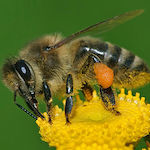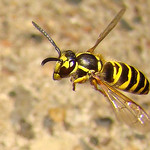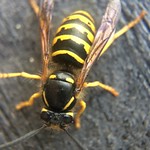 Honeybee |  Yellowjacket |  Paper Wasp |  Yellow Hornet |
A guide for patients
Classification: In North America there are over 16,000 species of insects of the order Hymenoptera. Of these, a few, less than 1%, can inflict venomous stings which may cause allergic reactions in humans. Hymenoptera responsible for most human stings include honey bees, yellowjackets, wasps, and hornets, some of which are pictured above. (If the yellowjackets and hornets in the picture look similar, it is because they are closely related, although hornets are substantially larger. See section on Hornets below).
All stinging insects are capable of causing severe reactions in susceptible individuals. No one can predict the severity of a reaction in a specific individual until after they have been stung.
Other stinging insects not covered in this review: Bumble bees, sweat bees, and harvester ants are hymenoptera but rarely sting humans and are not covered in this article. Imported fire ants and native fire ants, although important in the Southeastern and Southwestern U.S., are not seen in Northern California and are not covered in this article. The European Hornet has been imported to the Northeastern U.S. but only rarely stings and is not covered in this article.
Stinging insects of major importance
Honeybees
Honeybees are represented by only one species in the U.S., Apis mellifera. They live in large hives of up to 65,000 bees. Most hives are man-made, often wooden boxes painted white. These hives are commercially managed for honey production and pollination. Only the female stings. Bees have a squat hairy body with bright yellow or black stripes and are found around flowers or other blooming plants, particularly clover. Her stings can be identified because she is the only stinging insect which has a barb on her stinger which is left in the skin when she pulls away or is brushed off. (Correction: Dr. Mehrotra informs me that there is one species of yellowjacket that leaves a sting). Honeybees are not agressive and most stings occur in beekeepers or by accident when barefoot persons step on bees in a lawn or have bees caught accidentally in their clothing.
Yellowjackets
Yellow jackets are wasps of the genera Vespula and Dolichovespula. In other countries they are simply called “wasps.” Their nests are paper cells found in walls, logs, compost heaps, or underground. They are slightly smaller than honeybees and have yellow stripes on their abdomen. Yellowjackets exhibit aggressive behavior towards food, particularly meat, rotten fruit, and sweet drinks and have a characteristic, rapid, side to side flight pattern prior to landing.
Wasps
Although a wasp is any Hymenoptera of the suborder Apocrita which is not a bee, in the U.S. the term “wasp” usually refers to over 20 members of the species Polisties. Most wasps build their nests under eaves and rafters. The nest itself is a horizontal comb of paper cells with the underside completely exposed. Wasps have a characteristic narrow pinched waist which separates the upper chest area from a cigar shaped abdomen. Most wasps are nearly hairless and are black, red, or brown in color.
Hornets
In the U.S. there are no true native hornets. (The only true hornet in the U.S. is the European hornet Vespa crabro which only occurs in the Northeastern U.S). Members of the genus Dolichovespula are yellowjackets but are often referred to as “hornets.” Dolichovespula arenaria and Dolichovespula maculans are referred to as yellow hornet and white-faced hornet. Nests are football-shaped and are found in trees or shrubbery in wooded or open areas. Hornets are usually larger than most other stinging insects of the same family and have black bodies with yellow or white markings.
Types of Allergic Reactions to Hymenoptera stings: The usual reaction to an insect sting includes pain, redness and swelling at the sting site subsiding in 1-2 hours. These require only local treatment with ice packs and pain medication. Large local reactions with pain, redness, and extensive swelling around the sting site often peak at 48 hours and last as long as a week. These are rarely if ever infected. Treatment is with aspirin or NSAIDs (non-steroid anti-inflammatories drugs) such as ibuprofen, antihistamines, and if severe, a prescription of corticosteroids from your doctor.
Systemic reactions such as generalized hives (urticaria), deep swelling of the skin (angioedema), or anaphylaxis, a severe generalized allergic reaction can occur (see below). Individuals with severe reactions must seek immediate medical attention in a doctor’s office or emergency room since anaphylaxis from insect stings may be life-threatening and leads to approximately 40 deaths per year in the U.S.
How do I avoid stinging insects?
Avoidance of stinging insects starts with knowledge of their appearance and behavior. Be aware of where their hives or nests might be, and stay away from them. Don’t disturb nests of yellowjackets, wasps, and hornets, particularly if you are allergic to them. Nearby nests and hives should be removed by a professional.
Wear light colored clothing (insects are attracted to dark clothing), and wear socks and ankle-high shoes especially when walking on grass. Avoid wearing wool, leather or suede – insects can smell these odors. Don’t use perfumes, lotions and hair sprays. When they are nearby, avoid sudden, violent motions which will alarm them. Avoid picnicking outside and do not carry fruit, meat, or sweet foods or drinks which will attract these insects. Keep outdoor living areas clean and free of food refuse and garbage. Garbage cans should be covered. Insect repellents which help for biting insects, flies and ticks, are useless against stinging insects.
What are some of the treatments that are used in insect sting allergy?
Avoidance of stinging insects is very important and has been discussed (above). Usual non-allergic reactions and large local reactions have been discussed. For systemic reactions consisting of mild to moderate hives, an antihistamine or a single injection of epinephrine may be sufficient.
Anaphylaxis (a severe systemic reaction) may occur suddenly after a sting with hives, swelling of the skin, headache, itchy palms and throat, throat swelling, difficulty swallowing, nausea, vomiting, abdominal cramps, diarrhea, uterine cramps, lightheadedness, blurred vision, a feeling of impending doom, palpitations, low blood pressure, loss of consciousness and shock. Wheezing and shortness of breath may occur.
Self administered epinephrine in the form of Epi-pen or Auvi-Q may be lifesaving. Severe reactions should always be followed up with a visit to your physician or to an emergency room for further injections, oxygen, nebulized treatments, or even intravenous fluids. Seek immediate help for severe reactions as delays may be fatal!
If you have an allergic reaction to an insect sting, should you see an allergist?
Patients with systemic reactions to stinging insects should see an allergist for consultation and evaluation for venom immunotherapy (venom allergy shots). Skin testing for various venoms may be performed and blood work may be ordered to determine the insect venoms to which you may be allergic. Not all patients show the same results on diagnostic testing due to biologic variation among humans. Correlating patient history to skin testing and lab work is essential and requires considerable judgement and knowledge of venom allergy to assimilate all factors together and come up with a treatment plan. This should be done by an allergy specialist.
If your allergist decides to use venom immunotherapy, (allergy shots), they are usually given on a weekly basis for 3-5 months then once monthly for a year, after which shots may be extended to once every 6 weeks if they have been well tolerated. Venom immunotherapy has been effective in 97-100% of adults and children, and the small percentage of patients who were not protected experienced mild reactions and were really partial successes and not failures. For more information on insect allergy visit the websites www.aaaai.org or www.acaai.org.
*Photo attributions: Honeybee by Andreas Trepte; Yellowjacket by MJI Photos; Paper Wasp by Andreas Kay; Yellow Hornet by Jesse Christopherson